Storage tanks are an essential part of the oil & gas fields. They are mainly used to store different fluids or petroleum products. To transport fluids from places of production or processing units to end-users, we require storage tanks to store the products.
Storage tanks are a key factor in the expansion of dozens of industries. The petrochemical industry is a good example of the importance of storage tanks as it could not be formed without the capability to store a huge amount of crude and refined oil products in a safe and economic manner.
The majority of the storage tanks work under atmospheric pressure. According to API 620, the maximum allowable pressure for storage tanks is 15 psi and if the pressure exceeds these limits, it is considered as a pressure vessel.
Table of Contents
Floating Roof Tanks
The roof of the floating roof tank floats on a liquid stored at atmospheric pressure. It consequently rises and falls as the level of the liquid does inside the tank. Floating roof tanks are generally used to store volatile liquids to minimize the loss of the stored liquid product inside the tank due to evaporation by eliminate the free space above the stored liquid, and to ensure a safe environment around the storage tanks by reducing the fire hazard by limiting the volatile gases inside the tank
Besides, floating roof tanks are preferred over fixed roof tanks, as the tank’s size increases, the vapor pressure of the stored liquid increases, and when the flash-point is below the storage temperature. Click here to see the case study of the tank farm.
The roof of the floating roof tank consists of:
- An arrangement of buoyant compartments (pontoons) that floats on the fluid or liquid level.
- Mechanical means or tubular type seals are used to seal the gap between the floating roof and the tank wall.
- The roof is equipped with support legs that can be adjusted to hold it in either of two positions, the upper position that is enough to permit access for tank cleaning & maintenance, the lower position that keep the roof just above the inlet & outlet nozzles, drainage system, and other accessories or nozzles located at the tank’s bottom side.
Floating roof tanks are generally provided with rolling ladders. The tank
shell is earthed, the roof and all other fittings, such as rolling ladders, are appropriately bonded to the shell as a protection against lightning. All internals such as floating gauge, cables, mixers, etc. shall be well earthed to prevent the accumulation of electric charge inside.
Internal VS External Floating Roof Tanks
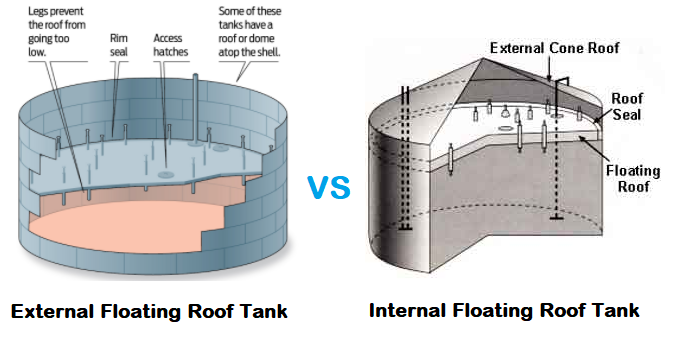
Specific differences between the external floating roof tank and the internal floating roof tank as follows:
- An external floating roof tank consists of an open-topped cylindrical steel shell equipped with a roof that floats on the surface of the stored liquid, rises and falls with the liquid level of stored fluid. Whereas, the internal floating roof tank has both, a permanently fixed roof and a floating roof inside. There are basically two types of internal floating roof tanks: tanks in which the fixed roof is supported by vertical columns within the tank storage area, and the tank with a self-supporting fixed roof and no internal support columns are provided.
- Both types of floating roof tanks can reduce evaporation loss greatly.
- Internal floating roof tank can prevent the stored liquid from being polluted by wind, sand storms, rain, snow, and dust. They can ensure the stored liquid quality in all weather conditions, whereas this facility is not possible with an external floating roof tank.
- With the same sealing condition in both types of floating roof tanks, an internal floating roof tank can further reduce the volatilization loss.
- Unlike the floating plate opened in an external floating roof tank, there can not be rain and snow load on the internal floating roof of the internal floating roof tank. Due to less load, a simple and light structure is required to build an internal floating roof tank.
- The internal floating plate can save accessories like a central drain and ladder that make it easy to construct and maintain.
- There is no gas space upon the liquid surface in the internal floating roof tank, it can reduce the waving of the liquid in the process of moving the liquid in the tank, prevent the inside wall of the tank from impact or by the internal pressure of the fluid, it also reduces corrosion of tank top and tank wall, and as a result, it enhances the service life of the storage tank.
- Compared with an external floating roof tank, internal floating roof tanks have more advantages, and therefore, their applications are wider.
- The perfect design of the internal floating roof tank is the best and it requires the least investment method to control volatilization loss from the fixed roof tank. Click here to know the design consideration of the Tank farm
Safety Requirements for Floating Roof Tank
- During operating conditions, the floating plate is not permitted to run over the indicated high level, also, in the same manner, it should not be located in the low level, to prevent the occurrence of a chuck or a floating plate sinking accident.
- Artificial measurement and sampling are not permitted in 12-18 h after the floating plate floated, to Prevent the fire and explosion caused by static electricity buildup.
- While adjusting the height of the floating roof support, the stem of the floating roof automatic vent valve must be adjusted together with all floating roof support.
- Due to the low temperature, the outlet of the drainage tube of the floating roof tank may freeze, thermal insulation is required at the exit, and the water in the drainpipe should be cleaned before it gets freeze.
- When the drainpipe is fully open for maintenance purposes, the workers should always check to prevent oil leakage while the tank is in use.
Fixed Roof Tanks
Fixed roof tanks are generally used in refineries to store the product that does not readily vaporize at ambient or stored temperature conditions.
The fixed-roof tank is less costly to construct and is generally considered the minimum acceptable equipment for storing liquids.
A typical fixed-roof tank consists of a cylindrical steel shell with a cone or dome-shaped roof that is permanently attached to the tank shell. These storage tanks are usually fully welded and designed for both liquid and vapor tight. Although, the older tanks often have a riveted or bolted construction and are not vapor tight.
A breather valve is commonly installed on many fixed-roof tanks, which allows the tank to operate at a slight internal pressure or vacuum. API 650 covers storage tanks with a maximum internal pressure of 2.5 PSIG. Weak shell-to-roof welds can be helpful to give protection to the tank shell in the case of excessive internal pressure. Fixed roof tanks shall be properly earthed which would help to protect from lightning.
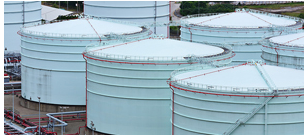
Considerations to Decide between Floating Roof Type and Fixed Roof Type
The decision tree below shows selection criteria between floating roof tanks and fixed roof tanks:
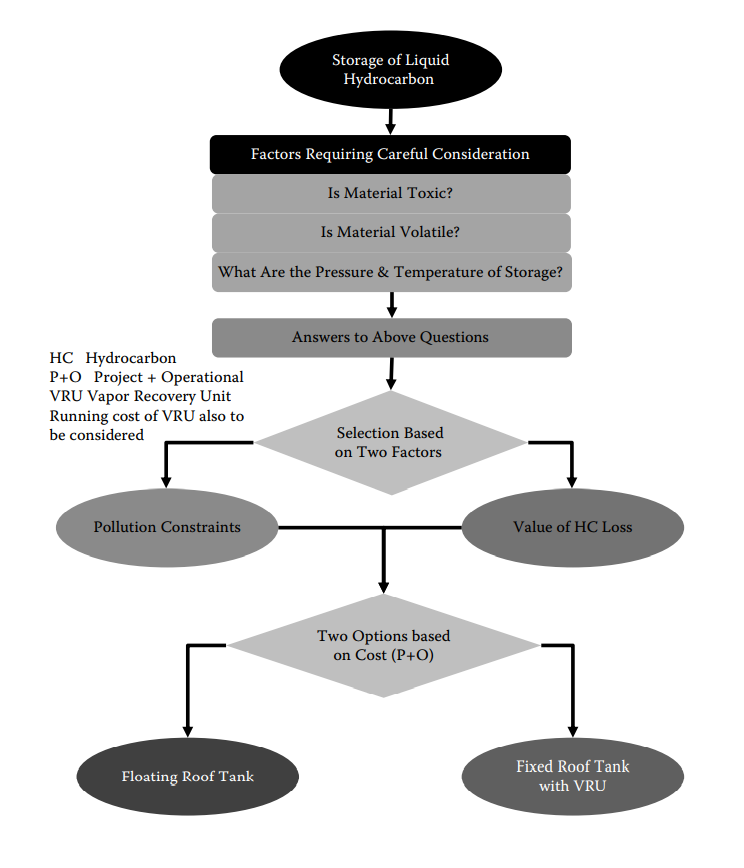
References
Above Ground Storage Tanks By Sunil Pullarcot
Above Ground Storage Tanks By Philip E. Myers
You may also like to read
Pump Piping Design Considerations
Piping Joint Types and Their Application
A Presentation on Expansion Loops
Different Types of Pipe Support Clamps & Hangers
A Presentation on Pipe Stress Analysis

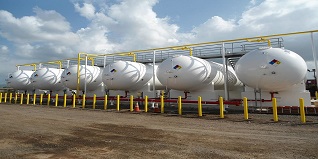
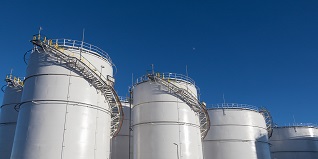
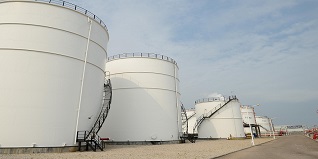
Great, your article is very informative and valuable . However, tanks are very essential in our daily life. To store the liquid and move the liquid we often use tanks.